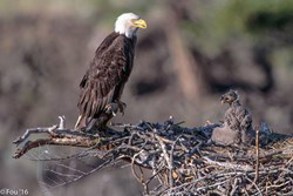
Bald eagles are protected by the Migratory Bird Treaty Act and the Bald and Golden Eagle Protection Act. These laws provide protection for the Bald Eagle and make the take of eagles or eagle nests illegal. The United States Fish and Wildlife Service (USFWS) defines “take” as “pursue, shoot, shoot at, poison, wound, kill, capture, trap, collect, molest or disturb.” USFWS also elaborates on “disturb” which is “to agitate or bother a bald or golden eagle to a degree that causes, or is likely to cause[...](1) injury to an eagle, (2) a decrease in its productivity, by substantially interfering with normal breeding, feeding, or sheltering behavior, or (3) nest abandonment, by substantially interfering with normal breeding, feeding, or sheltering behavior.”
Do I have a bald eagle nest on my property?
In Ohio and Indiana, the bald eagle nesting period begins in late January to early February and ends by late July. These birds nest near large water bodies (lakes, rivers, etc.) in natural features including large trees, cliff faces, and other rocky outcrops. They are also found on man-made structures such as electric poles and communication towers. The nests are large, measuring approximately 4 to 6 feet in diameter, at least 3 feet deep, and can weigh more than 1,000 pounds, making them very conspicuous. Restrictions on boating in the vicinity of an eagle's nest may also be an issue to keep in mind.
I am planning on developing land, should I be worried about bald eagles?
It is important to avoid any take of bald eagles and their nest sites. Coordination with USFWS is recommend if you suspect there is an eagle nest on or near your project site. USFWS has records of the locations of most bald eagles nests in Ohio and will notify you if there is a nest within a 1-mile radius of your project site.
If there is an eagle nest near your site, then certain avoidance and minimization measures should be implemented to reduce the likelihood of any impacts to the bald eagles. USFWS recommends that:
- No tree clearing can occur within 330 feet of nest or within any woodlot supporting a nest tree
- Any work within 660 feet of the nest or within the direct line-of-site of a nest be restricted from January 15 through July 31
If your project can not follow these measures and will result in incidental take of a bald eagle/nest, then permitting and additional coordination will be necessary.
Contact Your Local DRG Team For More Information On Permits Concerning The Bald Eagle.
Photo: Murray Foubister via Wikimedia Commons



